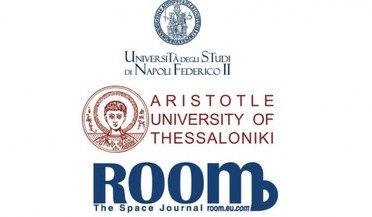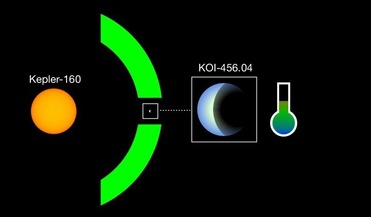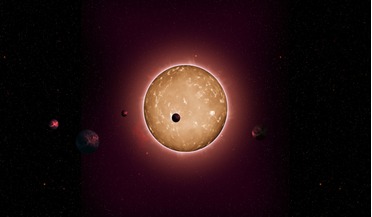ROOM: The Space Journal is one of the top magazines on space exploration, technology and industry. At ROOM, we share a common objective – promotion of peaceful space exploration for the benefit of humankind, all while bringing you fascinating articles on an array of popular topics. Our authors include academics and industry leaders from all over the world, which lets us bring you the newest and comprehensive information about kepler project exoplanets.
 April 2019
Scanning the skies for exoplanets
April 2019
Scanning the skies for exoplanets
...that will be 400 times larger than that covered by Kepler. Like Kepler, TESS will search for exoplanets by detecting the fractional dip in a star’s brightness as an orbiting exoplanet passes by, a technique known as the transit method.... their host stars in 13 days or less; these are considered short orbital period exoplanets. Conversely, Kepler was adept at finding exoplanets with orbital periods from 10 days up to a few hundred days, a feature ...
 August 2018
Exoplanet census promises radical discoveries
August 2018
Exoplanet census promises radical discoveries
... police radar guns to detect speeding cars. Figure 1: The sensitivity regions of the Kepler transit survey (in red) and the WFIRST exoplanet microlensing survey (in blue) are compared to the orbits of the planets in our ... planet or star in systems with more than one host star. The combination of the WFIRST exoplanet microlensing survey and Kepler’s transit survey will provide a complete statistical census of planets at all separations. This is the...
 November 2018
How many people does it take to colonise an exoplanet?
November 2018
How many people does it take to colonise an exoplanet?
... therefore is a useful guideline but not a strict, definitive number for colonisation projects. Artist’s concept of the surface of TRAPPIST-1f, an exoplanet about 40 light years from Earth. Cows in space? Sending a ship laden ... be launched in 2021). The HERITAGE project created and lead by Marin seeks to calculate precisely how humanity could endure a journey of several hundred years to Earth-like exoplanets. Camille Beluffi completed a PhD in ...
 September 2016
Paediatric cancer patients aim for the stars with space inspired art project
September 2016
Paediatric cancer patients aim for the stars with space inspired art project
... a job teaching and I began hitting the pavement exploring the potential for cross-sector public art projects that I could generate through community collaboration. I became increasingly interested in the role of public art ... that getting out of bed can keep you from getting bed sores or prevent pneumonia. HOPE - Suit 1. Project by project, I tried to explore new ways to motivate my patients, from giant collaborative sculptures like ‘Okoa the Wave...
 15 February 2017
ROOM joins two European universities in a project promoting space awareness
15 February 2017
ROOM joins two European universities in a project promoting space awareness
..., University of Naples Federico II (Italy) began in November 2016. The goal of this experimental project is to raise awareness on space-related topics among students and to promote educational and scientific exchange ... given the opportunity to exchange comments and participate in discussions on the ROOM website. The project aims to facilitate communication between university students in different European countries and increase their interest in...
 11 May 2016
Kepler scientists announce a major increase in confirmed exoplanet numbers
11 May 2016
Kepler scientists announce a major increase in confirmed exoplanet numbers
...24hrs a day, 7 days a week, 365 days a year looking for the tell-tale sign of a would be exoplanet. The technique Kepler uses is known as the transit method and it works by measuring the dip in star light as a planet passes... has been imperative to find a quicker solution and narrow down the search for true exoplanet signals. Batalha explains that Kepler achieves this by using statistics to sample the Galaxy to help understand how many planets ...
 05 June 2020
Exciting exoplanet find around sun-like star
05 June 2020
Exciting exoplanet find around sun-like star
... worlds, detections of rocky worlds around Sun-like stars is comparatively rare, due to the techniques used to find exoplanets. But by improving on an old detection method, a team of German and US scientists have now found a ... not new. It was discovered around ten years ago, followed by the confirmation of two exoplanets, called Kepler-160b and Kepler-160c, four years later. Both of these planets though are substantially bigger than Earth and...
 19 November 2018
Kepler officially retires after receiving final "goodnight" commands
19 November 2018
Kepler officially retires after receiving final "goodnight" commands
...spacecraft needs three functioning wheels to continally monitor a star’s brightness for signs of Earth-sized exoplanets, its field-of-view had to be switched roughly every three months to compensate for the ...Although no further observations will take place, Kepler’s legacy still continues. ”We know the spacecraft's retirement isn't the end of Kepler's discoveries," said Jessie Dotson, Kepler's project scientist at NASA's Ames Research Center in...
 24 November 2021
Astronomers discover more than 350 possible new exoplanets
24 November 2021
Astronomers discover more than 350 possible new exoplanets
...around smaller, dimmer red dwarf stars instead. Dubbed K2, this “Second Light" mission lasted as long as Kepler’s first exoplanet hunt and bumped its count of surveyed stars up to more than 500,000. But, after nine ... of data about once per month – is still being examined for signs of potential habitable exoplanets. However, because of the problems Kepler experienced, scientists have not been able to use the same automated processes used to find...